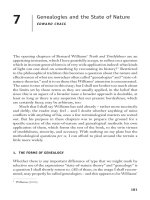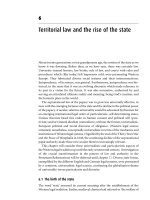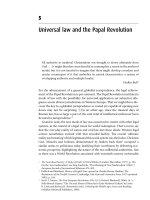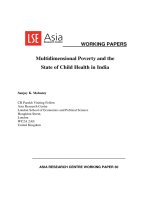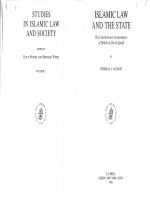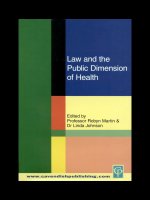Territorial law and the rise of the state
Bạn đang xem bản rút gọn của tài liệu. Xem và tải ngay bản đầy đủ của tài liệu tại đây (173.11 KB, 29 trang )
6
Territorial law and the rise of the state
About twenty generations or ten grandparents ago, the notion of the state as we
know it was dawning. Before then, as we have seen, there was certainly law.
University-trained lawyers, law books, rule of law, and courts with rules and
procedures which (like today) left laypersons cold, were permeating Western
Europe. They lubricated diverse social systems and their interconnections.
Jurisprudence, of its nature, was general. Furthermore, jurisprudence was his-
torical, in the sense that it was an evolving discourse which made reference to
its past in a vision for the future. It was also normative, authorised by and
serving an articulated ultimate reality and meaning, being God’s creation, and
the human’s place in the world.
The supranational law of the papacy was to grow less universally effective, in
tune with the emerging fortunes of the state and the decline in the political power
of the papacy. A secular, selective universality would be advocated by theorists for
an emerging international legal order of particularistic, self-determining states.
Various theorists based this order in human consent and political will (posi-
tivism) and/or rational idealism (naturalism), without the former, universalistic,
European political and moral discourse of allegiance. (Western legal science
remained, nonetheless, conceptually universalistic in terms of the mechanics and
institutions of Western legal systems.) Signified by the end of the Thirty Years War
and the Peace of Westphalia in 1648, the continuing decline of the supranational
papal authority made these new secular theories increasingly relevant.
This chapter will consider these universalistic and particularistic aspects of
the Western legal tradition up until the early seventeenth century. (Investigation
of the crucial transformation in the pattern of law and authority in the
Protestant Reformations will be deferred until chapter 7.) Diverse state forms,
exemplified by the different English and German legal systems, were permeated
by a common, universalistic legal science, continuing the globalisation theme
of universality versus particularity and diversity.
6.1 The birth of the state
The word ‘state’ assumed its current meaning after the establishment of the
Western legal tradition. Earlier, medieval charters had referred to ‘the welfare of
the kingdom’ (status regni) – ‘state’ was used as one would use the word ‘situ-
ation’. Justinian’s Corpus had addressed the ‘state’ or ‘situation’ of the Roman
republic (status rei Romanae). In the early thirteenth century, Accursius pio-
neered the modern usage, by writing of ‘the state’, of itself, as in ‘to preserve the
state so that it shall not perish’ (ad statum conservandum ne pereat).
1
By 1300,
Accursius’ idea of the state was gaining acceptance and overtones of patriotism
were emerging.
2
Not until the fifteenth century did states develop the fiction of
corporate legal personality separate from the civil society.
3
The significance of the medieval town to constitutional thought and law gen-
eration is often overlooked. In the eleventh and twelfth centuries, towns were a
major innovation in sovereignty, unevenly embedding frames of economic,
political and cultural interconnection in the emergence of sovereign polities.
4
As such, they are not totally devoid of analogy to the ‘urban geography’ of cities
today being physical sites ‘re-territorializing’ industries and markets and re-
negotiating authority and allegiances.
5
The cities which emerged were the first
secular polities, in the sense of being controlled by laity. Nonetheless, much of
their ‘spirit and character’ came from the church, displayed through ‘religious
values and rituals, including religious oaths’.
6
In addition to religious com-
monality, there was also a strong sense of social solidarity, brotherhood, friend-
ship and mutual aid in corporate guild and craft groups to protect economic
livelihood,
7
although freedom and equality did not reign supreme.
8
Parliaments have significant origins around this time in the representative
assembly, reflecting the ‘general climate of opinion’. Writings emerged on
feudal, customary and of course revived Roman law. This juristic discourse
advanced the rule of law ideal that ‘important decisions should be made pub-
licly, that customs should not be changed without general agreement, that
consent was necessary when the superior needed extraordinary additions to his
116 State Formation and Reformation
111
See R. C. van Caenegem, An Historical Introduction to Western Constitutional Law
(Cambridge: Cambridge University Press, 1995), pp. 5–6. Aquinas used the word ‘state’
similarly in the sense of the ‘state of the people of the Jews’: Alan Harding, Medieval Law and
the Foundations of the State (Oxford: Oxford University Press, 2002).
112
See Joseph R. Strayer, On the Medieval Origins of the Modern State (Princeton: Princeton
University Press, 1970), p. 57; see too Ernst Kantorowicz, The King’s Two Bodies: A Study in
Medieval Political Theology (New Jersey: Princeton University Press, 1957), pp. 232–62.
113
Philip Bobbitt, The Shield of Achilles: War, Peace and the Course of History (London: Penguin,
2003), p. 214. On the jurists’ fictions of the king’s two bodies – his office and his person – and
the perpetuity of ‘the People’ as a body politic, see Kantorowicz, King’s Two Bodies.
114
On the varying relationships of towns and cities to the emerging states, see Hendrik Spruyt,
The Sovereign State and Competitors: An Analysis of Systems Change (Princeton: Princeton
University Press, 1994) and p. 126 below.
115
See Saskia Sassen (ed.), Global Networks, Linked Cities (New York: Routledge, 2002).
116
Harold J. Berman, Law and Revolution: The Formation of the Western Legal Tradition
(Cambridge, MA: Harvard University Press, 1983), p. 362.
117
Antony Black, Guilds and Civil Society in European Political Thought from the Twelfth Century
to the Present (London: Methuen, 1984), pp. 12–17.
118
See Malcolm Barber, The Two Cities: Medieval Europe 1050–1320 (London: Routledge, 1992),
p. 52.
income, that “what touches all should be approved by all” ’.
9
The latter, funda-
mental proposition grew from the Romano-canonical maxim, Quod omnes
tangit ab omnibus approbetur.
10
Parliaments adapted to these historical legal
visions over time, although not always without challenge.
The sovereign state emerged from a variety of prototypical forms with varying
diversities of currency, weights, measures and military and administrative organ-
isation. In different ways, the prototypical states settled issues of independence
from outside powers and asserted final authority over populations within geo-
graphical boundaries or spheres of containable disruption. Evidently these pro-
totypical states were the most expedient political form for coping with internal
stresses and external threats, in effect ‘de-parcellising’ sovereignty, over centuries,
into larger, self-contained and homogeneous spheres of containable disruption.
England and France were to emerge as the two most centralised and sovereign of
states, after fighting strongly for fringe territories along frontiers; whilst German
principalities and Italian cities showed lesser signs of modern sovereignty.
11
6.2 Legal diversity and universality in the emerging European states
In today’s parlance, the later medieval lawyers sought to marry the global with
the local. The ‘Glossators’ were the post Papal Revolution jurists who revived
Roman law and assimilated it into the medieval legal systems. The glosses which
they produced were in the form of explanatory comments concerning Roman
law words, phrases and texts, including accepted usages and interpretations,
and answers to questions not settled by the texts.
12
The later ‘Commentators’ of
the fourteenth century onwards brought about the reception of Roman law into
Western Europe particularly with respect to the plurality of jurisdictions and
legal systems, transforming Justinian’s Corpus into ‘a common law for the whole
of Europe’ – ‘ius commune’.
13
The ius commune was the name given to the legal
science
14
– not necessarily doctrinal law – which was common to Germany,
France, Italy, Scotland and even England around the time of Bracton in the thir-
teenth century. R. H. Helmholz propounds the ius commune as an amalgam of
117 Territorial law and the rise of the state
119
Strayer, Medieval Origins, pp. 65–6.
110
See Gaines Post, Studies in Medieval Legal Thought: Public Law and the State 1100–1322
(Princeton: Princeton University Press, 1964), ch. 4.
111
Strayer, Medieval Origins, pp. 58–60.
112
See generally O. F. Robinson, T. D. Fergus, W. M. Gordon, European Legal History (London:
Butterworths, 1994), ch. 3.
113
Franz Wieacker, A History of Private Law in Europe, with Particular Reference to Germany,
trans. Tony Weir (Oxford: Oxford University Press, 1995), pp. 56–7.
114
‘Legal science’ refers to ‘every vocational occupation with the law’ according to Fritz Schulz, A
History of Roman Legal Science (London: Oxford University Press, 1967) and represents ‘an
institutionalization of the process of resolving conflicts in authoritative texts’ according to
Berman, Law and Revolution,p.160. See too Harold J. Berman and Charles J. Reid Jr, ‘Roman
Law in Europe and the Jus Commune: A Historical Overview with Emphasis on the New
Legal Science at the End of the Sixteenth Century’ (1994) 20 Syracuse Journal of International
Law & Commerce 1–31.
Roman law and canon law with feudal law occupying a secondary role.
15
James
Brundage observes five meanings from the historical writings: natural law, ius
gentium, Justinian’s Corpus, the canons of the Western church and, from the
thirteenth century, the Romano-canonical law of the universities.
16
The opposite of ius commune or common law was ius proprium or particular
law – the norms of local institutions such as the kingdom, principality, free city,
feudality, corporation or confraternity.
17
Uniquely balanced between historical
custom (particularity) and intellectual reason (universality grounded in Roman
law), the ius commune was something of a universalist way of dealing with diver-
sity. As Manlio Bellomo has written:
Plurality was thus part of the ‘system’, and the system itself was inconceivable and
would never have existed without the innumerable iura propria linked to the
unity of the ius commune. The greater imperfection of men’s laws (the ius pro-
prium) was related to the lesser imperfection of the laws of the rulers of the earth
(the ius commune), but both laws, in varying measure, contained and divulged
only a tenuous glimmer of the Justice that was absolute, divine, hence eternal.
18
Patrick Glenn has recently captured the complexity of this ‘common law’
notion. There was not just one ius commune system, but ‘multiple, interactive
common laws; each radiating out from major centers’, being ‘law common in
relation to law that was particular’.
19
The ius commune was part of a ‘relational
common law’, coexisting with, for example, the English common law, the
German gemeine Recht, the French droit commun coutumier and Italianate
regional common laws.
20
The value to a general, globalist jurisprudence is
apparent, given the interaction exposed in medieval jurisprudence between
universalistic and diverse human tendencies in the diffusion across Europe of
Romanist law and Western legal science.
21
A relatively common legal science
arose organically from diverse political organisations, prompted by the univer-
salism of the church and its canon law model. Legal pluralism flourished.
The emerging state systems of Germany and England prior to the
Reformations are briefly investigated to demonstrate this viable model for legal
pluralism and also the diverse paths but common origin of law in the interior,
personal dimension of the Space–Time Matrix – not the exterior, bureaucratic,
118 State Formation and Reformation
115
R. H. Helmholz, The ius commune in England: Four Studies (Oxford: Oxford University Press,
2001), pp. 3, 10.
116
James A. Brundage, The Profession and Practice of Medieval Canon Law (Aldershot: Ashgate
Variorum, 2004), VIII, pp. 238–9.
117
See Manlio Bellomo, The Common Legal Past of Europe 1000–1800,trans. Lydia G. Cochrane
(Washington, DC: Catholic University of America Press, 1995), p. xi, ch. 4.
118
Bellomo, Common Legal Past, p. xii.
119
H. Patrick Glenn, On Common Laws (Oxford: Oxford University Press, 2005), p. 19.
120
Glenn, Common Laws, pp. 42–3.
121
On the relevance of diffusion to globalisation, see William Twining, ‘Diffusion of Law: A
Global Perspective’ (2005) 49 Journal of Legal Pluralism and Unofficial Law 1–45; and more
relevantly for present purposes, William Twining, ‘Social Science and Diffusion of Law’ (2005)
32 Journal of Law and Society 203–40, 208–13.
political dimension. Space constraints prevent investigation of, for example,
France (centralised early, like England) and Italy (not united until the nine-
teenth century, like Germany). Neither of these two exclusions deviates from the
axiom that their later states originated, in terms of the Space–Time Matrix, in
the interior, cultural dimension of custom.
22
At once less bureaucratic and more
interior in origin on the Space Axis, exterior legitimacy also attached to the laws
of these emerging states through a Western legal science.
6.2.1 Germany
Germany has been a fragmented, decentralised state, perhaps more akin to a
federation of political communities, for most of its history. Centralisation was
not to succeed, even by the time of the demise of the Holy Roman Empire in
1806 (the real and spiritual power of which had been declining since the latter
thirteenth century).
23
Unlike the alliance which the French kings had forged
with the towns, the German kings had allied themselves with the lords, at the
expense of the towns. German kings, in their efforts to achieve the aspirations
of the Holy Roman Empire, had also sought control over Italy. This also
required the support of the dukes and ecclesiastical lords to grant them control
over the towns, at the expense of obtaining any real authority over the lords.
24
In effect, the German kings alienated the towns and were indebted to the lords
in a bargain honoured by none of the parties.
In opposition to the feudal governmental structures and the imperial pre-
tensions of the papacy and the Holy Roman Empire, the German free towns
formed the city-league. From this grew a federation of towns, the Hanseatic
League, in the thirteenth century, peaking in the fourteenth and fifteenth cen-
turies. As a major economically unifying force in Europe embodying emerging
ideas for good government, the Hansa was not merely ‘an economic associa-
tion’; ‘like states it waged wars, and on occasion it could make or break kings’;
and it could ‘send emissaries, sign treaties, collect revenue, enforce Hansetag
decisions . . . raise an army, conduct foreign policy, decree laws, engage in social
regulation, and collect revenue’.
25
Hendrick Spruyt maintains that the Hanseatic League provides evidence for
‘a viable way of organizing economic and political activity in the absence of a
central authority’,
26
in contrast to the state model. Nonetheless, if sovereignty
is considered in the modern sense to encompass a final decision-making struc-
ture with a monopoly on violence and justice within broad territorial bound-
aries, city-leagues failed this measure. They were small islands of containable
disruption in the tempestuous seas of other rulers. Furthermore, the Hansa
119 Territorial law and the rise of the state
122
See generally Spruyt, Sovereign State; and Glenn, Common Laws.
123
Martin van Creveld, The Rise and Decline of the State (Cambridge: Cambridge University
Press, 1999), p. 100.
24
Spruyt, Sovereign State, p. 109.
125
Ibid., pp. 123–6. See too Wilhelm G. Grewe, The Epochs of International Law, trans. Michael
Byers (Berlin: Walter de Gruyter, 2000), p. 58.
26
Spruyt, Sovereign State, pp. 126–8.
could not manage to provide standard weights, measures and coinage, nor to
enforce centralised justice or revenue raising. The Hanseatic League also faced
difficulties obtaining recognition in international politics, for example, at the
Peace of Westphalia (to which we shall come later in this chapter), because the
League could not bind all members to the agreements.
27
Despite the loose empire of Germany – some 350 principalities – there was a
strong German ‘common law’. This comprised the canon law common to the
whole of Western Europe and its universities and bishops’ courts, which
included Roman law and its revival scholarship, as well as German customs
worked into this system. The proportion of Roman law was low relative to
custom, because of the diffusion of customary laws. Particular custom or ius
proprium was, however, accommodated by the universalistic method. Courts of
leading cities provided guidance to the other cities, fostering a common
approach. The very large territories (Länder), in developing their legal institu-
tions, borrowed extensively from one another.
28
Contrary to the impression
perhaps created by its political fragmentation, Germany featured a legal sophis-
tication and coherence. The customary law, which operated at the secular level,
was administered by a lay (as opposed to university-trained legal professional)
staff, Schöffen, which systematised the custom in ‘mirrors’ reflecting the territo-
rial customs of the people. The authority of the Schöffen was grounded not in
university learning but ‘on practical experience and familiarity with life, and
perhaps even more on their social position’.
29
The Schöffen had to rely upon the
learned clerk of the city to cope with the submissions of the legal professionals
who practised the ‘learned law’ of the ius commune. This was a centralising,
imperial phenomenon, which had begun earlier in Bavaria. The Schöffen of the
larger cities had sometimes been merchants who were aware of other regimes,
and they were often the subject of appeal for law (responsa) by ‘daughter’ towns.
‘[O]ne of the greatest of the tribal laws’ or ‘mirrors’, premissed in the authority
of Christian political theology, was the Sachsenspiegel (Mirror of the Saxons).
30
This was itself a transportable, common law.
31
There was, then, a strong histor-
ical, customary basis for the German secular positive law, attracting allegiance
by virtue of its location towards the interior orientation of the Space Axis, whilst
featuring an exterior rationality.
To cope with the increasing diversity of interconnections, in the absence of a
legal profession as such practising customary law (as was the case in England),
learned lawyers were imported from the law faculties in Italy and later their
German offspring. Roman law and canon law had been applied to secular
120 State Formation and Reformation
127
Ibid., pp. 163–70.
128
See Harold J. Berman, Faith and Order: The Reconciliation of Law and Religion (Atlanta:
Scholars Press, 1993), p. 92; Harding, Medieval Law, pp. 99–108.
129
Wieacker, Private Law, p. 82.
130
See Wieacker, Private Law, p. 78; see too Harold J. Berman, Law and Revolution, II: The Impact
of the Protestant Reformations on the Western Legal Tradition (Cambridge, MA: Harvard
University Press, 2003), p. 34.
31
Glenn, Common Laws, pp. 37–9.
litigation in ecclesiastical courts since the thirteenth century. In the second half
of the fifteenth century, the ius commune was applied regularly in the secular
courts by learned judges.
32
A formal reception of Roman law occurred in
Germany and its Holy Roman Empire in 1495, amidst an established movement
for public peace, with the establishment of the Reichskammergericht as a refur-
bished imperial supreme court of justice. Together with other new courts of
justice staffed by Romanist jurists, the German princes, it is widely accepted,
were attempting to create a rational government order to suppress violence.
33
(This violence, we shall see in the next chapter, inspired Luther and his juristic
cofactor, Phillip Melanchthon, in their reforming efforts.) Written procedure
was emphasised. Although restricted primarily to imperial courts, Romano-
canonical procedure was used gradually to supersede the oral forms by 1505.
Given that the court, as a court of appeal, could not be expected to have tech-
nical knowledge of the law and customs of the many different trial jurisdictions,
Roman law was applied by default unless local law was specifically pleaded.
34
This reflected an older subsidiarity principle relevant especially to EU law
today:
35
the most local of laws could receive the highest authority, in the absence
of reasons to the contrary.
36
Contrary to the private law in England,
37
the universities played an import-
ant role in the development of Romanist German jurisprudence, particularly
after the reception of Roman law. At the end of the fifteenth century, the opin-
ions of the law professors were obtained, by despatch of record to a university
for consideration (Aktenversendung).
38
The usus modernus Pandectarum (the
modern application of the Pandects, or, literally, Justinian’s Corpus) was used by
the faculties, transcending boundaries of princes and taking authority from the
imperial source.
39
This is perhaps best considered ‘an intellectualisation of
German law and lawyers’
40
[original italics]. The universal tolerance of particu-
larity and diversity therefore declined with the growth of prototypical German
state institutions and the Roman law, whilst still drawing on a long Romanist
legal tradition for authority. Movement towards the exterior orientation of the
Space Axis was occurring.
6.2.2 England
In analysing the growth of the absolutist state, Perry Anderson, in passing,
described the England relevant to the present enquiry as ‘the strongest mediaeval
121 Territorial law and the rise of the state
132
See Wieacker, Private Law, pp. 83–90, 113–18.
133
Whitman, Legacy of Roman Law, pp. 12–13.
134
See Robinson, European Legal History, [11.3.3]; Bellomo, Common Legal Past, pp. 217–20.
135
See ch. 11, section 11.2.5, p. 263 below.
36
Glenn, Common Laws,p.19.
137
As will be seen (see ch. 7, section 7.2.1, pp. 148–50), the public law tradition in England did at
times draw on Roman law for authority.
138
See Robinson, European Legal History, [7.4.1]–[7.4.2]; Wieacker, Private Law, pp. 136–7;
Whitman, Legacy of Roman Law, pp. 34–5.
39
Robinson, European Legal History, [11.4.4].
140
Wieacker, Private Law, p. 95.
monarchy in the West’.
41
Saxon kings had centralised the country efficiently. By
the time of Norman feudalism in the later third of the eleventh century, England
possessed an administrative centralisation which, when taken with the original
conquest and modest size of the country, generated ‘an unusually small and
regionally unified noble class, without semi-independent territorial potentates
comparable to those of the Continent’.
42
Towns were part of the royal estate as a
consequence of the Norman conquest in 1066, when all land in England became
held of the crown (a fiction which survives to this day even in Australian land
law). Towns were never powerful enough to challenge their subordinate status;
and the clergy was not so powerful either, comparatively. It will surprise some to
learn that the English common law which arose at this time was essentially
imported by the French conquerors.
43
There was initially coexistence between royal courts and manorial, feudal and
church courts. The royal courts were not, though, the ‘regular professional
justice’. Royal courts were extraordinary as there were no permanent adminis-
trative, legislative and judicial bodies operating on their own authority.
44
From
an early stage, parliaments emerged as ‘collective institutions of the feudal
ruling class’, coinciding with the boundaries of the country. From the time of
Edward III (reigned 1327–77), barons and bishops in the English parliament
were represented alongside knights and towns. The courts which emerged
‘blended’ the royal jurisdiction with surviving local customary courts. Courts
‘retained vestiges of their original character as popular juridical assemblies in
which the free men of the rural community appeared before their equals’; evolv-
ing into ‘an unpaid aristocratic self-administration’ in the counties, from which
the then judicial role of the Justice of the Peace was to emerge.
45
Similarly to the
German common law, the English common law had (and to a very limited
extent still has today) an inherent subsidiarity principle, deferring to more
locally established custom.
46
The similarities between classical Roman and English legal science often go
unnoticed. Both Roman law and English common law developed though a case-
based discourse. In both systems, law ‘developed’ out of an assumption that the
relevant law actually existed, although not yet articulated, and that the scope
simply needed definition. The development of English law, like Roman law, was
concentrated upon particular forms of action, such that legal discussion was
concerned with remedies rather than with rules. This was exemplified by the
formula granted by the praetor in Rome, published in his edict; and by the writ
granted by the Chancellor in England, published in a register of writs. The clas-
sical procedure of English common law, like Roman law, divided legal actions
122 State Formation and Reformation
141
Perry Anderson, Lineages of the Absolutist State (London: NLB, 1974), p. 113.
142
Anderson, Lineages, pp. 113–14.
143
R. C. van Caenegem, European Law in the Past and the Future: Unity and Diversity over Two
Millennia (Cambridge: Cambridge University Press, 2002), pp. 2–3.
144
See Berman, Law and Revolution, p. 441.
45
Anderson, Lineages, pp. 114–16.
146
See Glenn, Common Laws, pp. 25–32.
into two stages: at the first stage, the legal issue was identified; and the second
stage concerned proof and the adjudication of the issue. In both systems, the
second stage was assigned to laymen: the jury in England and the iudex in Rome.
If the jury or iudex found the allegations proved, judgment would be ordered
against the defendant.
47
The laymen’s decisions in fact replaced the judgment of God – which was
supposed to have been channelled through nature, for example, by trial by
ordeal or battle. The award of money damages was the only remedy the laymen
could provide, ‘probably because of the transitory nature of their office; once
they had given their verdict, their office ceased to exist’. When remedies other
than money came to be required, the first such remedies issued were the inter-
dict by the praetor himself in ancient Roman times, and the injunction by the
Chancellor in the English system, who restricted the common law judges to
control of the writ system. This is how, in time, the systems evolved of the ius
honorarium of the Roman praetor and the equity of the English Chancellor,
48
which in England was to develop in its own jurisdiction separate from the
common law until 1875.
49
There is a difference between a similar legal science as opposed to similarities
in legal doctrines. That is, similar systems of procedure can exist with marked
doctrinal differences. There can be similarities in legal science although much
less in common, doctrinally. For example, there was no major English ‘recep-
tion’ of Roman law as there was on the Continent. That is, English law could not
be derived as a matter of principle by practitioners from Roman jurisprudence.
Yet the doctrinal similarities should not be dismissed: ‘rather than speaking of
conscious borrowings, one must speak instead of parallels, of similarities of lan-
guage, of coincidences that seem too striking to be coincidental’.
50
It is perhaps
going too far to suggest that commonalities may have arisen from the time of
the withdrawal of Roman troops from England in the fifth century.
51
The
Anglo-Saxon invaders knew nothing of Roman law or canon law, although after
they converted to Christianity in the seventh century they began to write down
their laws, probably with some trace of Roman law. King Ethelbert of Kent had
compiled or codified the laws of his Kingdom (c.600 CE) in ‘Roman fashion’.
52
The Norman invasion in the mid-eleventh century had eschewed any rele-
vance of Latin charters used to record conveyances of land until that point, and
it was not until the first century after the conquest that the Leis Willelmi appeared
with ten short extracts which seemed to be borrowed from the Digest. Like the
123 Territorial law and the rise of the state
147
Peter G. Stein, ‘Roman Law, Common Law, and Civil Law’ (1992) 66 Tulane Law Review
1591–1604, 1592–3.
48
Ibid., 1593–4.
149
See J. H. Baker, An Introduction to English Legal History (London: Butterworths, 4th edn
2002), pp. 114–15.
150
Charles Donahue Jr, ‘Ius Commune,Canon Law, and Common Law in England’ (1992) 66
Tulane Law Review 1745–80, 1748.
151
Cf. Edward D. Re, ‘The Roman Contribution to the Common Law’ (1993) 39 Loyola Law
Review 295–311, 300.
152
Re, ‘Roman Contribution’, 302. Cf. Donahue, ‘Ius Commune’, 1750.
efforts of Vacarius in England, they were intended to set down a few principles
of Roman law that might be useful for practitioners.
53
The Treatise called
Glanvill contained considerable knowledge of Roman law, effectively displayed
in the classification of actions of debt and in the dialectical method.
54
No doubt
this was because Glanvill was the student of Vacarius, the first law professor in
England, who founded the civil law school at Oxford. (English common law was
not taught in English universities in earnest until 1753 at Oxford.)
55
The second
major treatise on the practice of the central royal courts, buoyant with Roman
legal science, was Bracton on the Laws and Customs of England,arranged accord-
ing to the tripartite persons, things and actions scheme of Justinian’s Institutes,
with extensive citation of the Corpus Iuris Civilis (the entire body of Justinian’s
texts, including the Institutes, Digest, Codes and Novels).
56
Sir Henry Maine
ventured to call Bracton’s work ‘the plagiarisms of Bracton’.
57
Indubitably, the private law doctrinal development of the common law and
the civil law took on considerable differences,
58
to the point suggested by Alan
Watson that ‘the stress on similarities in these two approaches is . . . funda-
mentally misplaced, and leads to serious misunderstandings of the two systems,
and of legal development in general’.
59
Obviously there were differences in the
systems. Yet a categorical acceptance of Watson’s assertion would be to overlook
‘the essential kinship, not of the Roman and the English law, but rather of the
Roman and the English lawyer’;
60
and the similar constitutional development of
European kingdoms
61
and the common legal science.
62
By the end of the fifteenth century, the King’s Council, which had come to
handle more of the judicial business of the type which had previously been pre-
sented to parliament, generated a separate court, the Court of Requests, ‘which
had a distinctly Romano-canonical form of procedure, and which for this
reason had a number of civil lawyers among its personnel’. In the sixteenth
century, the Court of Star Chamber was also born of King’s Council, which fol-
lowed the Continental inquisitorial form of procedure used by the council.
63
The doctrines and procedures of the Chancellor’s court, eventually the Court of
124 State Formation and Reformation
153
Re, ‘Roman Contribution’, 302.
54
Donahue, ‘Ius Commune’, 1751–2.
155
See Baker, English Legal History, p. 170.
56
Donahue, ‘Ius Commune’, 1752.
157
Sir Henry Sumner Maine, Ancient Law: Its Connection with the Early History of Society and its
Relation to Modern Ideas [1861] (reprinted Dorset Press, 1986), p. 67.
158
See van Caenegem, Western Constitutional Law,p.7.
159
Alan Watson, ‘Roman Law and English Law: Two Patterns of Legal Development’ (1990) 36
Loyola Law Review 247–74, 248.
60
W.W. Buckland cited in Watson, ‘Roman Law’, 248.
161
van Caenegem, Western Constitutional Law, p. 7.
162
After the notable continental codification initiatives from the late eighteenth century onwards,
modern civil lawyers attempting to understand ‘the true nature of Roman law’ may even have
been disadvantaged compared to common lawyers: Obrad Stanojevic, ‘Roman Law and
Common Law – A Different View’ (1990) 36 Loyola Law Review 269–74, 274; Eugen Ehrlich,
Fundamental Principles of the Sociology of Law,trans. Walter L. Moll [1913] (Cambridge, MA:
Harvard University Press, 1936), pp. 254–95.
163
The Star Chamber procedure was part of the controversy which contributed in the following
century to the English civil war.
Equity, showed considerable influence from the ius commune, and for some
time civil lawyers practised before it. The church courts, from the middle of the
thirteenth century, followed the substantive canon law and Romano-canonical
procedure, and the High Court of Chivalry, emerging from the fourteenth
century, also followed the Continental procedure.
64
Whilst common law lawyers were not required to have training in the ius
commune of the Continent, some of the common law lawyers were learned in
it. Early on, the university at Bologna had trained many English ecclesiastics in
canon law, which inspired a familiarity with Roman law which re-entered
England in the student’s intellectual baggage.
65
Many lawyers practising in
England before the English revolution possessed polymathic qualifications
including civil law training,
66
and many English judges tended to be quite
learned in the ius commune. Before 1600, references by common law practi-
tioners and judges to Continental law increased markedly. This included resort
to Roman legal classifications such as ‘public and private, criminal and civil, real
and personal, property and possession, contract and delict, among other exam-
ples’, borrowed from Roman civil law and canon law taught in European uni-
versities. Between 1300 and 1600, more than 200 cases contained propositions
from canon law or civil law, excluding the many mentions of Latin maxims
derivable from Continental sources.
67
Indeed, ‘England was never entirely cut
off from continental legal culture.’
68
At no point, however, in the absence of English local law, was reference made
to the ius commune for an authoritative statement of the law, as was the prac-
tice on the Continent.
69
Why was there not a more profound reception of
Roman law doctrine in England? A number of suggestions have been made.
Perhaps it represented a historical rejection by the English of papal and imper-
ial influence.
70
Perhaps, too, the uniquely feudal landholding law fundamental
to English law (comprising ‘convoluted’ estates doctrine) was simply incongru-
ous with Roman law.
71
Perhaps most significantly and uniquely, England had
125 Territorial law and the rise of the state
164
Donahue, ‘Ius Commune’, 1754–5; see too Helmholz, Ius Commune,p.3; Berman, Law and
Revolution II,pp. 212–13; van Caenegem, European Law,pp. 19–21.
165
Charles Homer Haskins, The Renaissance of the Twelfth Century (Cambridge MA: Harvard
University Press, 1927 reprinted 1993), p. 211.
166
See David J. Ibbetson, ‘Common Lawyers and the Law Before the Civil War’ (1988) 8 Oxford
Journal of Legal Studies 142–53, 147, on the disproportionate contribution of English lawyers
to the renaissance; Brian Levack, The Civil Lawyers in England 1603–1641 (Oxford: Clarendon
Press, 1973).
167
David J. Seipp, ‘The Reception of Canon Law and Civil Law in English Common Law Courts
Before 1600’ (1993) 13 Oxford Journal of Legal Studies 388–420, 388–91.
168
See Reinhard Zimmermann, ‘Savigny’s Legacy: Legal History, Comparative Law, and the
Emergence of a European Legal Science’ (1996) 112 Law Quarterly Review 576–605, 588.
169
Donahue, ‘Ius Commune’, 1747.
170
See James Muldoon, Empire and Order: The Concept of Empire, 800–1800 (New York: St
Martin’s Press, Inc., 1999), p. 96.
171
See Alan Watson, The Evolution of Western Private Law (Baltimore: The Johns Hopkins
University Press, expanded ed. 2001), pp. 244–7.
